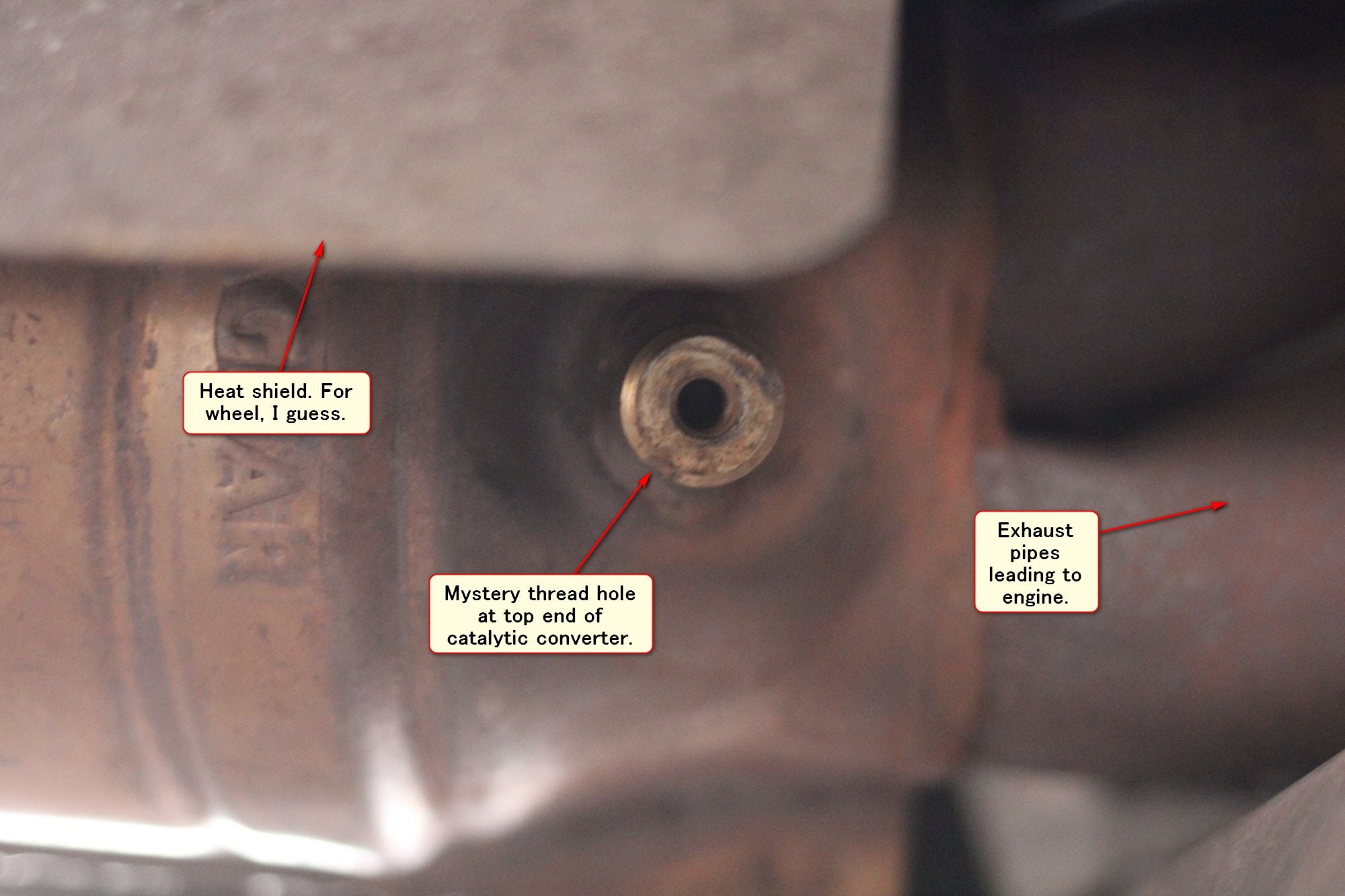What Does Cat Converter Do? Unveiling the Mystery and Power Behind Its Function!
A catalytic converter reduces harmful emissions in a vehicle’s exhaust system. A catalytic converter is an essential component of a vehicle’s exhaust system.
It plays a crucial role in reducing harmful emissions that can pollute the environment. The device contains a catalyst, usually made of platinum, palladium, and rhodium, which facilitates chemical reactions that convert toxic gases, such as carbon monoxide, nitrogen oxides, and hydrocarbons, into less harmful substances like carbon dioxide, nitrogen, and water vapor.
This process helps to minimize the negative impact of vehicle exhaust on air quality and contributes to reducing pollution levels. Therefore, a functioning catalytic converter is vital for ensuring that vehicles meet emissions standards and play their part in protecting the environment.
Why Cat Converters Are Vital For Your Vehicle’s Performance And Emissions Control
Why Cat Converters Are Vital for Your Vehicle’s Performance and Emissions Control
Modern vehicles are equipped with catalytic converters, commonly known as cat converters, which play a crucial role in maintaining optimal performance while minimizing harmful emissions. These devices are essential for ensuring that your vehicle complies with environmental regulations and contributes to a cleaner and healthier environment.
Cat converters primarily function by converting harmful gases produced during the combustion process into less harmful substances. They contain precious metals, such as platinum, palladium, and rhodium, which act as catalysts to aid the chemical reactions. By promoting the oxidation of pollutants like carbon monoxide, nitrogen oxides, and unburned hydrocarbons, cat converters help reduce their harmful effects on both human health and the environment.
Moreover, cat converters contribute to enhancing engine efficiency. By maintaining a proper air-to-fuel ratio, they ensure optimal combustion, resulting in improved fuel economy and increased power output. This makes cat converters essential for performance-oriented vehicles as well.
Overall, cat converters play a crucial role in reducing harmful emissions and enhancing engine efficiency, making them an integral part of modern vehicles.
How Cat Converters Work: A Closer Look At The Mechanism Behind Their Function
How Cat Converters Work: A Closer Look at the Mechanism Behind Their Function
Understanding the Basic Components of Cat Converters
The catalytic converter plays a crucial role in reducing harmful emissions from vehicles. It contains three primary components: the substrate, the catalyst, and the exhaust manifold. The substrate is typically made of a ceramic honeycomb structure with a large surface area to facilitate the conversion process. The catalyst consists of precious metals like platinum, palladium, and rhodium, which help initiate and accelerate the chemical reactions. The exhaust manifold connects the catalytic converter to the engine’s exhaust system.
The Catalytic Conversion Process: Breaking Down Harmful Pollutants
When exhaust gases pass through the catalytic converter, the catalyst triggers oxidation, reduction, and hydrolysis reactions, converting harmful pollutants such as carbon monoxide, nitric oxides, and unburned hydrocarbons into less harmful substances like carbon dioxide, nitrogen, and water. This conversion process takes place at high temperatures, facilitated by the exhaust system’s heat.
Exploring Different Types of Cat Converters and Their Operation
| Type of Cat Converter | Operation |
|---|---|
| Two-way converters | They handle the oxidation of carbon monoxide and unburned hydrocarbons. |
| Three-way converters | They can reduce carbon monoxide, unburned hydrocarbons, and nitric oxides simultaneously. |
| Pre-catalysts | They reduce the pollutants during the cold start-up phase, preparing the main catalytic converter for efficient operation. |
Key Features Of Cat Converters: Unveiling Their Design And Composition
Key Features of Cat Converters: Unveiling Their Design and Composition
Substrate Materials: Unraveling the Backbone of Cat Converters
A critical component of catalytic converters is the substrate material, which acts as the backbone of these emissions control devices. Typically, two types of substrates are used:
| Ceramic Substrate | Metallic Substrate |
|---|---|
| Composed of materials like cordierite or silicon carbide | Constructed using stainless steel or other metal alloys |
| Offers a high surface area for catalyst contact | Provides excellent durability and chemical resistance |
| Efficient in converting pollutants at lower temperatures | Offers enhanced heat resistance and mechanical strength |
Catalyst Coating: Enhancing Efficiency and Effectiveness
The catalyst coating on the substrate plays a crucial role in the efficiency of catalytic converters. Typically, precious metals like platinum, palladium, and rhodium along with other materials are applied as a thin layer. This coating provides an active surface for chemical reactions that convert harmful emissions into less harmful substances.
Heat Shielding and Insulation: Protecting the Converter and the Vehicle
Cat converters require effective heat shielding and insulation to safeguard not only the converter itself but also the surrounding vehicle components. Insulating materials, such as ceramic fibers or metal foils, help to retain the converter’s heat within a specific range. Heat shields, typically made of steel or aluminum, further protect other critical parts of the vehicle from excessive heat exposure.
The Role Of O2 Sensors In Cat Converters: Analyzing Exhaust Gas Composition
The Role of O2 Sensors in Cat Converters: Analyzing Exhaust Gas Composition
Introduction to Oxygen (O2) Sensors in Modern Vehicles
Modern vehicles are equipped with oxygen (O2) sensors as part of their emissions control system. These sensors play a crucial role in the operation of catalytic converters (cat converters).
O2 sensors monitor the oxygen levels in the exhaust gases and provide feedback to the vehicle’s engine control unit (ECU). This data helps the ECU adjust the air-fuel mixture for optimal combustion, resulting in reduced emissions.
O2 Sensors and Their Connection to Cat Converter Operation
The information provided by the O2 sensors is used to determine if the air-fuel mixture is too rich or lean. If the mixture is too rich, the O2 sensors detect an excess of unburned fuel. In this case, the ECU adjusts the fuel injection to reduce the richness of the mixture.
A properly functioning cat converter uses this information to convert harmful gases, such as carbon monoxide (CO) and nitrogen oxides (NOx), into less harmful substances like carbon dioxide (CO2) and water vapor. The O2 sensors ensure that the cat converter is operating efficiently by monitoring the exhaust gas composition.
O2 Sensor Failures and Their Impact on Cat Converter Performance
Failure of the O2 sensors can significantly impact the performance of the cat converter. If the sensors provide inaccurate or no data, the ECU may not be able to adjust the air-fuel mixture properly. This can lead to increased emissions, decreased fuel efficiency, and potential damage to the cat converter itself.
It is crucial to regularly inspect and replace faulty O2 sensors to ensure the proper functioning of the cat converter and compliance with emission regulations.
What Happens When Cat Converters Fail: Identifying Signs, Causes, And Solutions
What does a catalytic converter do? It plays a vital role in reducing harmful emissions from your vehicle’s exhaust system. When it comes to identifying signs of a failing cat converter, there are a few warning signals to watch out for. One common sign is a decrease in engine performance, such as a loss of power or acceleration. Another indicator is the presence of a strong rotten egg smell, caused by sulfur in the exhaust. Additionally, you may notice an increase in fuel consumption or a decrease in fuel efficiency. When it comes to the causes of cat converter malfunction, there are several possibilities, including engine misfires, fuel contamination, and overheating. Diagnosing and dealing with cat converter issues requires a professional inspection and potentially replacing the faulty converter. It is crucial to address these issues promptly to ensure optimal vehicle performance and to minimize environmental impact.
Repairing Or Replacing A Failed Cat Converter: The Best Approach
Understanding the feasibility of repairing a catalytic converter is crucial when faced with a failed component. Several factors need to be considered before making a decision between repair and replacement. First, the age and overall condition of the converter play a significant role. If the converter is relatively new and the remaining components are in good shape, repair may be a viable option. Additionally, the extent of the damage should be assessed, as minor issues can often be fixed by a skilled technician, ensuring cost-effectiveness.
However, certain situations may warrant replacement. If the cat converter has extensive damage, such as a broken or clogged substrate, it might not be feasible to repair. Moreover, if the converter repeatedly fails or if the entire exhaust system is in poor condition, replacement is usually recommended. When considering a replacement, it is crucial to select a high-quality cat converter that meets the vehicle’s specifications. Ensuring compatibility and efficiency will help maintain the optimal performance and emissions control of the vehicle.
Ensuring Longevity And Optimal Performance Of Cat Converters: Maintenance Tips
In order to ensure the longevity and optimal performance of your catalytic converter (cat converter), regular vehicle maintenance is essential. This includes taking steps to protect your cat converter from physical damage and ensuring proper fuel quality and engine operation.
One of the key ways to protect your cat converter is to avoid driving over rough terrain or debris-filled roads whenever possible. Additionally, avoiding excessive acceleration and abrupt stops can help minimize wear and tear on the cat converter.
Regularly inspecting your vehicle for any signs of physical damage to the cat converter, such as dents or leaks, is also important. If any damage is detected, it should be repaired promptly to prevent further issues.
Ensuring proper fuel quality is another important factor in cat converter maintenance. Using quality fuel and avoiding contaminated or diluted fuel can help prevent damage to the converter. It’s also a good idea to avoid running the vehicle on low fuel levels, as this can increase the risk of overheating and damaging the cat converter.
Lastly, maintaining a properly functioning engine is crucial for cat converter longevity. Regular engine tune-ups, including checking and replacing faulty spark plugs, oxygen sensors, and other engine components, can help prevent excessive emissions and reduce the strain on the cat converter.
| Tips for Maintaining Cat Converter Longevity |
|---|
| Avoid driving on rough terrain or debris-filled roads |
| Avoid excessive acceleration and abrupt stops |
| Regularly inspect for physical damage and promptly repair if necessary |
| Use quality fuel and avoid contaminated or diluted fuel |
| Avoid running the vehicle on low fuel levels |
| Perform regular engine tune-ups and replace faulty components |
Final Thoughts: The Remarkable Functionality Of Cat Converters
What Does Cat Converter Do
Final Thoughts: The Remarkable Functionality of Cat Converters
Subheading: Appreciating the Importance of Cat Converters in Our Everyday Lives
Taking Steps Towards a Cleaner and Greener Future
The cat converter, or catalytic converter, is an essential component of modern-day vehicles. Its primary function is to reduce harmful emissions, specifically nitrogen oxides, carbon monoxide, and hydrocarbons, that are produced during the combustion process. By utilizing a catalyst, typically consisting of platinum, palladium, and rhodium, the cat converter facilitates various chemical reactions that convert these harmful gases into less harmful substances. This helps to prevent air pollution and the negative impacts it has on both human health and the environment.
The environmental benefits of cat converters cannot be overstated. By converting harmful gases into less harmful ones, cat converters play a significant role in reducing smog, acid rain, and even global warming. Through their implementation, we can take steps towards a cleaner and greener future.
In addition to promoting environmental well-being, cat converters also contribute to the overall performance of vehicles. By regulating the flow of exhaust gases, they help improve engine efficiency and fuel consumption, resulting in better mileage and less pollution.
Overall, the cat converter is an indispensable component of modern vehicles. Its remarkable functionality allows us to appreciate the importance it holds in our everyday lives. With its ability to reduce harmful emissions and improve performance, the cat converter proves to be a crucial tool in our collective efforts for a more sustainable future.

Credit: www.jaguarforums.com
Frequently Asked Questions For What Does Cat Converter Do
Can A Car Run Without A Catalytic Converter?
Yes, a car can run without a catalytic converter. However, it is illegal in some places due to emissions regulations. Removing the catalytic converter may cause the engine to produce higher levels of harmful pollutants. It is best to check local laws and consult with a professional before removing the catalytic converter.
What Happens When Cat Converter Is Removed?
Removing the catalytic converter reduces emissions control, leading to increased pollution. It is illegal to remove it, and doing so can result in penalties and damage to the vehicle’s engine.
What Is The Purpose Of A Cat Converter?
A catalytic converter is used in vehicles to reduce emissions and convert harmful gases into less harmful ones. It helps in reducing air pollution and ensures compliance with environmental regulations.
How Do You Know If You Need A Catalytic Converter?
A catalytic converter is needed if your vehicle emits excessive exhaust emissions. It helps reduce harmful pollutants, such as carbon monoxide and nitrogen oxides, into less harmful gases. Get it checked if you notice poor engine performance, increased emissions, or a strong sulfur smell.
Conclusion
To sum it up, the catalytic converter is a crucial component in a vehicle’s emissions control system. Its primary function is to convert harmful pollutants into less harmful substances, making our cars more eco-friendly. Understanding how the cat converter works and its importance in reducing air pollution is essential for every vehicle owner.
Remember to maintain and replace your cat converter regularly to ensure optimal performance and to protect the environment.






